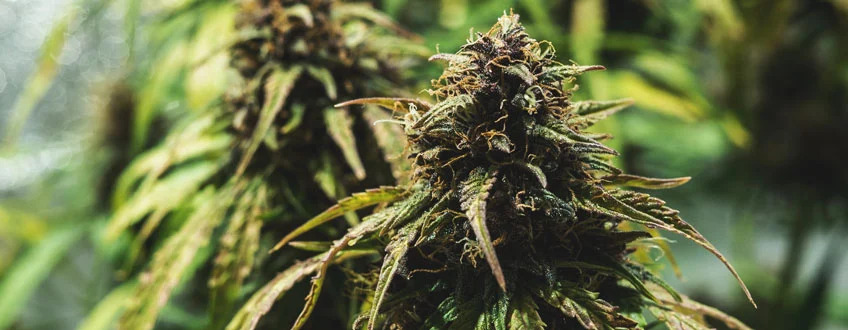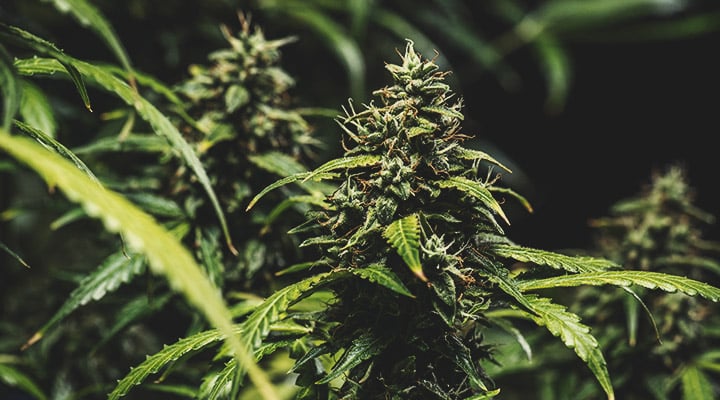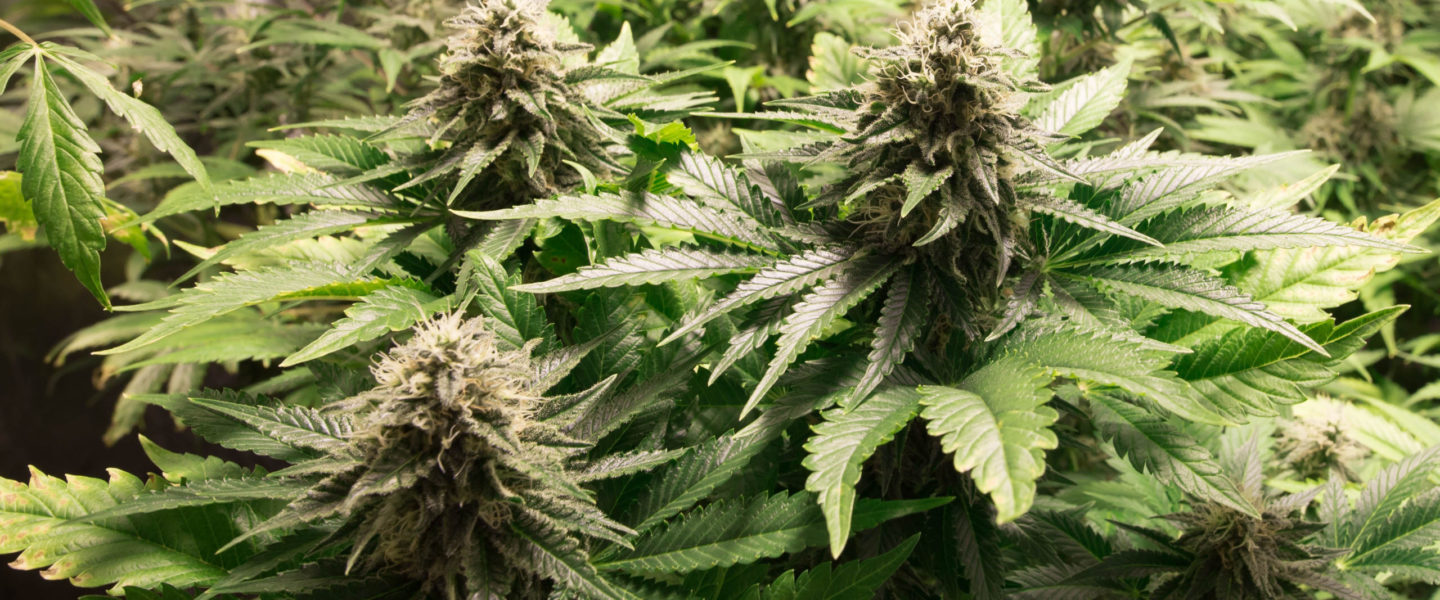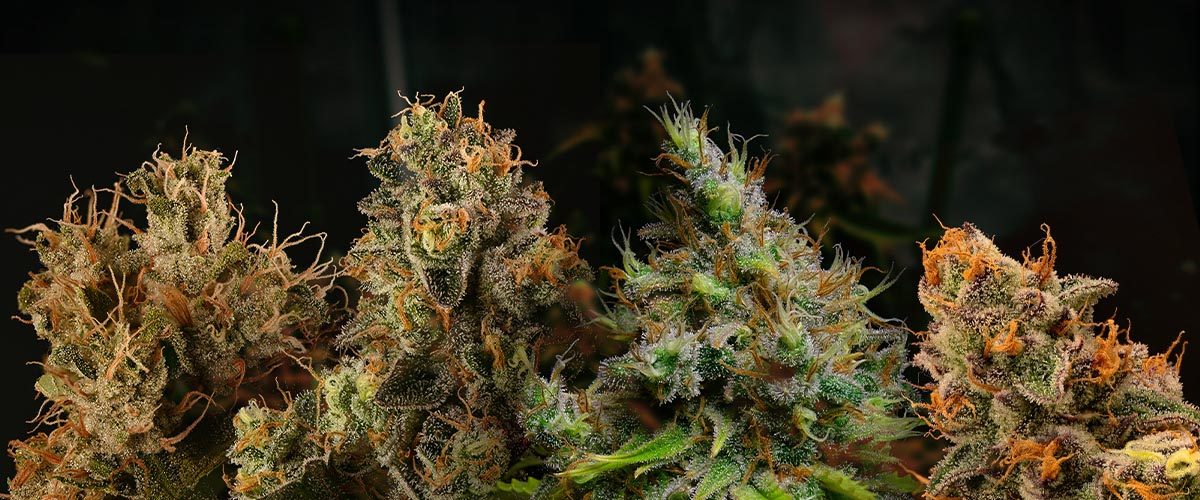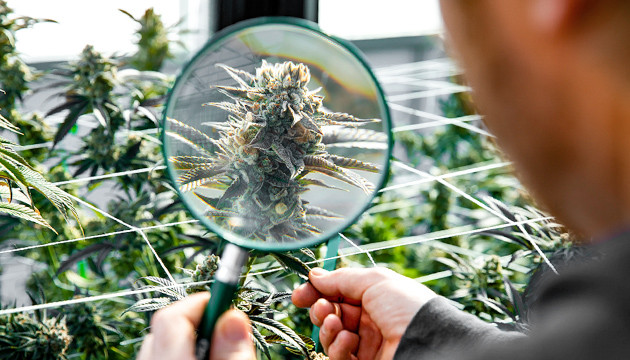Plantes à autofloraison sont connues pour leurs cycles de croissance rapide et peuvent généralement être récoltées plus tôt que les plantes photopériodes. Le délai typique entre la graine et la récolte pour une autofloraison est généralement d'environ 10 semaines, mais peut parfois aller jusqu'à 16 semaines selon la variété. D'autre part, plantes de cannabis Indica prennent généralement entre 8 et 9 semaines tandis que les variétés Sativa peuvent prendre jusqu'à 12 semaines.
Savoir quand récolter de la marijuana peut être délicat car cela dépend de quelques facteurs tels que ce que vous désirez du produit fini, la variété, l'environnement et ses conditions. Si vous souhaitez un effet plus Indica, une récolte précoce est recommandée, tandis que si vous préférez un effet plus Sativa, cela peut prendre un peu plus de temps avant la récolte.
Les feuilles de cannabis commenceront également à perdre leur couleur et deviendront plus pâles avec des poils orange rouille sur les fleurs femelles et mâles ; cependant, cela peut être différent selon la variété, car certains hybrides peuvent avoir des queues de couleurs différentes ou fournir des signaux différents qui nous indiquent quand récolter notre récolte.
Récolte basée sur les saisons
La récolte basée sur les saisons est une étape importante pour obtenir des rendements plus élevés. La principale chose à considérer est la quantité de soleil que vous recevez quotidiennement et le moment où récolter. En planifiant, vous pouvez ajuster votre calendrier de culture en conséquence et tirer le meilleur parti de vos plantes à autofloraison au moment de la récolte.
Lors de la récolte, il est préférable de le faire tôt le matin avant le lever du soleil et, pour une meilleure pratique, de laisser vos plantes dans l'obscurité totale pendant environ 48 heures avant. Cela augmente les trichomes d'une plante alors qu'elle entre dans sa phase finale de croissance, lui permettant d'atteindre son plein potentiel.
Lorsque vous cultivez en intérieur, vous n’avez pas besoin d’attendre le lever du soleil puisque vous pouvez simplement éteindre les lumières de votre tente sans attendre la lumière naturelle. Cela garantit que vos plantes savent que la mort approche et les amène à déployer tous leurs efforts pour produire des trichomes.
Cela vaut la peine de prendre en compte le temps et les efforts supplémentaires lors de la récolte en fonction des saisons. Avec une bonne planification et en suivant ces étapes, vous pouvez maximiser les rendements et avoir une excellente saison de récolte !
Rinçage (Flushing)
Le rinçage de vos plantes de cannabis à autofloraison avant la récolte est une étape importante à ne pas sauter. Cela implique d'éliminer l'excès de nutriments du substrat et des racines, donnant ainsi aux plantes le temps d'utiliser tous les sucres restants et autres nutriments qu'elles ont stockés.
Cela contribuera à garantir que vos têtes soient lisses et délicieuses, avec une odeur et un goût délicieux. Le rinçage aide également à éliminer toute dureté potentielle causée par une brûlure minérale due à un trop grand nombre d'éléments nutritionnels présents dans vos têtes.
La fenêtre des récoltes
La fenêtre de récolte est une partie importante du cycle de vie de toute usine automobile. C’est le moment où la plante est prête à être récoltée et à profiter des fruits de son travail. Ce n’est pas seulement le moment où vous pouvez récolter vos fruits, mais c’est aussi le moment de vous assurer que votre plante a été correctement entretenue tout au long de son processus de culture à autofloraison et qu'il donnera le produit de la plus haute qualité possible.
La fenêtre de récolte commence après la maturation d’un bourgeon, puis d’autres le suivent rapidement. Les feuilles deviennent jaunâtres en vieillissant, indiquant que votre autofloraison n’absorbera plus les nutriments une fois le rinçage commencé.
À ce stade, vous devez mesurer les trichomes avec un microscope, surveiller la flexibilité et l'épaisseur de la tige, inspecter la maturité des bourgeons et prendre en compte d'autres variables telles que l'odeur, la saveur et l'état général de la grappe de fleurs.
La prise en compte de tous ces éléments vous aidera à déterminer quel est le moment idéal pour récolter, garantissant un profil de résine parfait avec des fleurs richement colorées pleines d'huiles essentielles et de terpènes pour des résultats de profil de saveur optimaux.
Calendrier approximatif de l'éleveur
Le calendrier approximatif d'un éleveur (A breeder's approximate schedule) pour la croissance des plants de cannabis peut être un guide utile en matière de récolte. Comme les éleveurs cultivent généralement du cannabis de niveau professionnel dans des installations avancées, les délais annoncés par les éleveurs ne sont pas toujours infaillibles. Dans de nombreux cas, les producteurs amateurs peuvent se retrouver avec des temps de maturation plus courts ou plus longs que ceux spécifiés dans le calendrier de l'éleveur.
La quantité de lumière, la température et la ventilation contribuent toutes à la rapidité avec laquelle votre culture mûrit. Certains producteurs peuvent constater que leurs jardins sont plus rapides et doivent récolter plus tôt que prévu, tandis que d'autres peuvent se rendre compte qu'ils sont plus lents et devraient retarder leur récolte.
Il est important de se rappeler que ces informations ne peuvent pas remplacer les décisions de surveillance et des horaires appropriées basées sur l’observation du développement de votre culture, car il existe de nombreuses variations en fonction de la configuration et des conditions de chaque producteur.
Lorsque vous remarquez une baisse de la consommation d’eau
Quand vous cultiver du cannabis, il est important de surveiller la consommation d’eau. Comme la plante approche de la fin de son cycle de vie et est sur le point d’être récoltée, elle aura naturellement besoin de moins d’eau que lorsqu’elle était plus jeune. Cela signifie que le sol devrait sécher plus rapidement que d'habitude après l'arrosage. Si vous constatez que votre plante mûrit normalement mais n’utilise pas trop d’eau, cela pourrait être le signe qu’il est presque temps de la récolte.
Vous devez notamment en tenir compte lorsque vous prenez votre décision de récolter, mais ne pas vous fier uniquement à cela comme seul paramètre pour décider du moment où le faire. Au lieu de cela, d’autres facteurs, comme l’examen des pistils et des trichomes et l’évaluation de leur maturité, devraient également être utilisés en conjonction avec la constatation d’une diminution de l’absorption d’eau.
Jaunissement et mort des feuilles nourricières
Lorsque vos plants de cannabis atteignent la fin de leur cycle de vie, il est normal de commencer à remarquer un jaunissement et la mort des feuilles nourricières. C'est le signe que votre chasse d'eau fonctionne correctement et que votre plante n'est plus capable d'absorber les nutriments contenus dans le sol.
Pendant ce temps, les niveaux d’azote diminuent dans les tissus végétaux, ce qui entraîne le jaunissement et la chute des feuilles. Cela crée finalement une fumée moins âpre après la récolte après séchage et durcissement des têtes pour la consommation. Il est important de noter que le cannabis reçoit toujours de faibles niveaux d'azote provenant de bactéries bénéfiques présentes dans le sol lorsqu'il n'y a aucun élément nutritif présent dans les engrais en bouteille ou les N-P-K.
Ce processus aide à créer des protéines, des acides aminés et d’autres composants nécessaires à la photosynthèse dans les feuilles nourricières actives pendant leur période de floraison. Bien que ces feuilles finissent par jaunir et mourir au fur et à mesure du rinçage, cette diminution de la disponibilité des nutriments permet d'obtenir un produit de qualité optimale après la récolte.
Les calices deviennent prune
Le calice est l’un des composants les plus importants d’une plante de cannabis. Il protège les organes reproducteurs et recouvre les bourgeons, c’est ce qui donne à la marijuana son aspect distinctif. Au fur et à mesure que la plante mûrit au cours de son cycle de croissance, les calices gonflent et se développent pour former une fleur complète.
Au cours de ce processus, les feuilles autrefois petites et vertes deviennent charnues en forme et en taille. Cela se produit en raison d’une augmentation de l’humidité et du flux de sève, ces deux éléments font partie intégrante de la pollinisation lorsque les plantes se reproduisent sexuellement.
Au moment de la récolte, il est clair de voir quels bourgeons se sont complètement développés, ils doivent être dodus et ronds avec une coloration brun clair unique aux variétés de cannabis. Lors de l'inspection de votre plante, vous pouvez vérifier qu'elle est à maturité en examinant les calices, car ils devraient maintenant être suffisamment grands pour recouvrir les graines de cannabis qu'ils contiennent.
Couleur des stigmates
La couleur des stigmates des plants de cannabis est un indicateur essentiel du moment où ils sont prêts à être récoltés. Les longs organes ressemblant à des poils qui dépassent du bourgeon commencent généralement par une couleur vert blanchâtre et deviendront bruns puis rouges au fur et à mesure de la maturation.
Bien que certaines plantes à autofloraison puissent avoir des pistils bruns même s'il leur faut quelques semaines de plus avant la récolte, il peut être difficile de savoir exactement quand récolter et cette méthode ne nécessite aucun équipement spécialisé mais n'est pas très précise ni fiable.
Comme de nouveaux pistils peuvent apparaître du jour au lendemain, ce qui peut alors retarder la récolte de plusieurs jours, il est important de suivre le nombre de stigmates bruns et fanés pour évaluer la véritable maturité de la plante.
États des trichomes
Les trichomes sont les glandes résineuses d'une plante de cannabis qui produisent une variété de composés tels que les terpènes et les cannabinoïdes. Ce sont de minuscules bulles scintillantes sur les têtes de la plante de cannabis et qui ressemblent à de petites grappes de trichomes blancs ou clairs.
En mûrissant, ils peuvent changer de couleur du blanc à l'ambre ou même au noir, selon la variété. Grâce à ces glandes, les plantes peuvent créer des huiles essentielles et d’autres composés aromatiques qui dégagent des arômes agréables lorsqu’ils sont fumés et confèrent une grande variété de saveurs et d’effets lorsqu’ils sont consommés.
Récolte précoce versus Récolte tardive
Si vous êtes obligé de décaler votre date de récolte, il est important de garder en tête la maturité des trichomes au moment de la récolte. Même si une récolte précoce peut contribuer à améliorer certains terpènes et cannabinoïdes, vous sacrifierez le développement des trichomes, ce qui peut réduire considérablement la teneur en cannabinoïdes.
De même, une récolte tardive peut entraîner une diminution de la puissance globale des terpènes et des cannabinoïdes à mesure que les trichomes se dégradent avec le temps avec une exposition prolongée à l'air. En tant que tel, il est important d'évaluer combien de temps s'est écoulé depuis que la plante a commencé la phase de floraison ainsi que d'étudier tout changement dans le développement des trichomes avant de décider quand récolter pour des rendements optimaux.
Récolte précoce
Lorsqu’il s’agit de récolte, le timing est primordial. Si quelque chose oblige à une récolte précoce ou tardive, vous pourriez passer à côté de toute la puissance de vos plantes. Si vous devez récolter plus tôt que le moment optimal, les trichomes ne seront pas encore complètement développés et manqueront de puissance.
De plus, certains terpènes qui apportent de la saveur et de l’arôme peuvent ne pas se développer pleinement s’ils sont pris trop tôt. Par conséquent, sans trichomes matures et sans développement complet de terpènes, vous ne tirerez pas le meilleur parti de vos têtes en les utilisant.
Récolte tardive
La récolte tardive fait référence au processus consistant à retarder la coupe des plants de marijuana au-delà de leur maturité maximale normale afin de maximiser le succès de reproduction. Cela inclut généralement une réduction du THC disponible, à mesure que les trichomes commencent à vieillir et à devenir ambrés, modifiant ainsi les effets que l'on ressentirait en consommant du cannabis.
Malgré cela, une récolte tardive peut quand même donner des résultats bénéfiques en fonction de l’effet recherché. Par exemple, si un effet de type Indica est recherché, permettre aux trichomes de passer du nuage à l'ambre peut favoriser une relaxation plus profonde en transformant le THC en d'autres composés cannabinoïdes tels que le CBN.
Cela étant dit, la marijuana doit être récoltée au bon moment si un effet de type sativa est souhaité en raison des conversions en THC, ce qui modifierait les effets ressentis en fumant ou en vaporisant.
Comment récolter, sécher, tailler et affiner parfaitement votre culture de cannabis
Récolter parfaitement votre culture de cannabis est essentiel pour tirer le meilleur parti de votre rendement à autofloraison. Que vous soyez un cultivateur expérimenté ou novice, récolter au bon moment peut faire une énorme différence dans la qualité et la puissance de votre produit.
Tout d’abord, il est important de surveiller les trichomes pour détecter tout signe de maturité car des trichomes clairs comme du verre indiquent que les têtes ne sont pas encore tout à fait prêtes et les trichomes de couleur ambrée indiquent une maturité presque parfaite pour la récolte. Une fois que les bourgeons atteignent leur pleine maturité, vous devrez couper soigneusement chaque bourgeon fleuri sur sa tige séparément à la base de chaque branche.
Après la récolte, il est important de donner aux plantes un certain « temps d’arrêt » en les suspendant la tête en bas dans un endroit frais et sombre avec une bonne circulation d’air afin qu’elles puissent commencer leur processus de séchage. Au cours de cette étape, vous souhaiterez les surveiller de près à mesure qu’ils commencent à développer leurs changements d’arôme et de couleur, ce qui indique qu’ils sont presque prêts à être taillés.
Récolter votre culture
La récolte de votre culture de cannabis est une partie importante du processus de culture des plantes de marijuana. Il existe différentes méthodes pour réduire votre récolte de cannabis selon que vous cultivez en intérieur ou en extérieur.
Si vous avez de l'espace pour suspendre la plante entière, il peut être préférable de la couper d'un seul coup, car cela prend moins de temps et les plantes de cannabis d'intérieur dépassent rarement 1,5 mètre de hauteur. Cependant, lors de la culture en extérieur, l’espace peut être plus limité et il peut donc être préférable d’abattre des branches individuelles de votre culture.
Cela vous permettra de vous adapter davantage à toutes les salles de séchage dont vous disposez et de minimiser également tout désordre potentiel qui pourrait survenir si vous essayez d'accrocher des branches plus grosses ou des plantes entières à la fois. Prendre soin lors de la récolte de votre récolte garantira que la quantité maximale de têtes de qualité puisse être obtenue de chaque plante, alors assurez-vous toujours que vous prenez les bonnes mesures lorsque vous réduisez votre récolte.


 English
English 